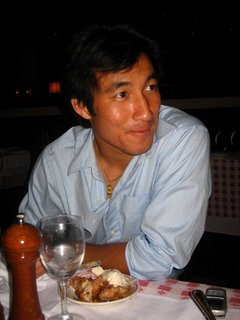Music is a 2-dimensional Language of Forms
I've been asking these questions of all my teachers and musically inclined friends, "what exactly is it that you are 'hearing' ?" I can't take that word for granted anymore, I need to know what it is that people really mean when they say it. For the longest time, I've been totally confused about it, getting different tips and ideas and advice on the topic: from the jist of it it seems that some advocate interval ear training and others advocate 'relation to the tonic' ear training. Recently I decided that since advocates of one method really didn't know how to address the other method (to me at least), I will have to divide my ear training time between both horizontal and vertical ear training, respectively. For now its just a matter of expanding my awareness but as it gets more comfortable, I'll have to start stepping up the intensity of practice. This article confirms it.
Music as a Language:
http://graham.main.nc.us/~bhammel/MUSIC/muslang.html
"....Events and activities - time slicing gives a sequence of complex events which might miss important cross relations. It is better to hear what is being expressed, i.e., all that is going on both vertically and horizontally. To "hear" music is not something that is innate, and not something that requires no effort. Nor can it be done without learning and practice, yet that *is* what is required. To hear and understand music as it expresses itself, is at least as difficult as for one whose mother tongue is English to learn to hear, read and understand Tamil. Speaking it, is another matter...."
"Music can also be analyzed as architecture where the parts have function and form only with regard to the whole. An architecture of integrity is of a whole when it proceedes from unifying principles, one of which is the collection of its substantive materials. The materials are seen to generate the whole: the form of a chaconne has as unifying principles, its customary 3/4 signature, a tonality, and a recurring harmonic sequence upon which a sequence of variations is constructed constituting the chaconne."


5 Comments:
Hi,
As a (good) jazz improviser, you need to be able to play the ideas in your head effortlessly and accurately by ear. And, of course, you need to have good ideas that fit in with the rest of the music. That's really all there is to it. The vertical vs. horizontal, time slicing, architecture of integrity, etc... stuff makes it more complicatd than necessary IMHO.
Ear training part can be accomplished by a variety of methods but learning intervals is probably the best starting point for somebody starting with weak skills.
There are a couple of free online ear training tools here that can help you from the beginning (intervals) through advanced exercises (random melody call-and-response with modulation).
http://www.iwasdoingallright.com/tools/ear_training/
4:15 AM
Rick, do you ever have trouble recalling lines in your head ? Sometimes I feel like I have to 'forcefully' repeat certain ideas in my mind's ear until they start coming back to me before my fingers start playing it. In fact, sometimes I have to stop myself from touching the keys first until I've made sure that I can hear the melody in my head.
ie: A few weeks agao I started transcribing the head to Bud Powell's "Celia". When I sat down to play it, I still wondered how much of my fingering was really being informed by my ear, instead of just intellectualizing the key positions. The way I tried to tackle this was by singing the head starting from all 12 different pitches. Still, when I sit down to play in the different keys, I still feel as if my fingers are waiting for my 'head' to command them, rather than my 'ear'. I think part of this is due to my fingers' lack of familiarity with playing 'by intervals', am too used to just sightreading and then relying on muscle memory.
8:13 PM
Wesley,
There really aren't that many times I'm actually trying to remember a line ahead of time. If anything, I'd sort of rather not remember things too well so I'm not constantly playing the same ideas over and over again.
But, when I do want to remember a line, I make sure I can sing it perfectly. This comes back to the idea of playing simple songs (one of my ear trainers helps with that). Simple songs are so ingrained in our minds that we don't really have to think before we sing/play them. You need to have that level of familiarity with anything you're trying to remember.
As for short improvised lines, it may help to practice call-and-response. My random melody feature is good for that. When I first started, 4-note phrases were hard to remember and play by ear. Now, I can do 7- or 8-note phrases. That sort of memory is especially useful for playing motifs and modulating them, twisting them around, etc.
4:01 AM
Thanks Rick. Cool blog you've got btw. I actually found it a few weeks ago and posted a link to it earlier last month. Good luck with your progress, very nice ear training program. How did you find my blog btw?
11:45 AM
I'm glad you like the ear trainer. I noticed your site in my referrer logs so I thought I'd check it out...
2:31 PM
Post a Comment
<< Home